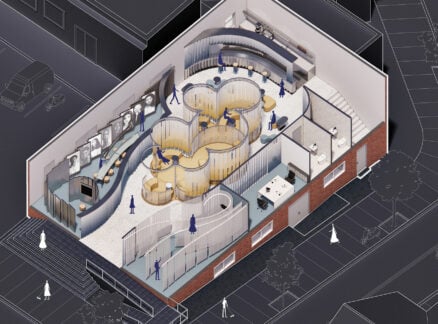June 1, 2011
Crossover Appeal
Todd Bracher’s impeccable design credentials have caught the eye of an increasingly sophisticated contract-furniture market.
Back in March, we profiled an impressive group of emerging American product designers (“American Progress,” by Eva Hagberg, p. 66). We wanted to look at their careers, their creative and business philosophies, and their strategies for success as a way of assessing the state of American design. As it turned out, everyone had a slightly different story. There was no single way forward. But of the seven designers (and four firms) we profiled, Todd Bracher was the one who really seemed to be on the cusp of a commercial breakthrough. A Long Island–born designer who spent more than a decade abroad, he had developed such a rarified portfolio that when he returned home in 2007, he was perceived as a European. When we talked to him in March, Bracher was busy prepping for Milan and working feverishly on three new products for NeoCon: a furniture collection for HBF, a carpet-tile collection for Shaw, and a conference chair for Humanscale. His sudden ubiquity at NeoCon testifies to the narrowing gap between high design and the contract-furniture market.
HBF
The Nest Collection
Todd Bracher’s work with HBF began with a recommendation from the designer Jeffrey Bernett. The brief was to design a collection of collaborative furniture, pieces that could both stand alone and exist in a more traditional lounge setting. Collaboration is the buzzword in workplace design today, but Bracher and HBF felt they had to observe firsthand how it really worked. “We discovered in many cases that ‘collaborative furniture’ goes mainly unused because people have the fear of looking unproductive, of looking too comfortable, or of just not understanding how to use the furniture,” Bracher says. “Collaboration may not always require laptops, but sometimes notebooks, sometimes even just a cup of coffee, and we took all scenarios into consideration.”
The inspiration for the line was not technology or equipment or software but something more primal: the idea of a bird’s nest, where users could feel safe, comfortable, and engaged in their own space, as well as enjoy a degree of privacy. The chair has a looping wooden frame, which becomes the arm and back and body support behind the seat, and a three-dimensional polyester mesh, which naturally supports the body while offering semi-privacy. HBF—whose expertise is in wood craftsmanship—also used a five-axis CNC router, which allowed its designers to create more complicated shapes than traditional wood-milling equipment would have.
One of Bracher’s biggest challenges in creating the lightweight chair
was conforming to BIFMA standards. The prototypes underwent extensive testing to evaluate such variables as weight loads, seating durability, and arm- and backrest strength. “It is tempting to be enamored by the lightness and simplicity of ‘European design.’ However, understand that, typically, these pieces would never pass the demands of BIFMA,” Bracher says. “I am proud that with HBF we were able to balance an aesthetic solution with the physical and legal demands of BIFMA, in an elegant, lightweight, reliable package.” —Paul Makovsky
SHAW CONTRACT GROUP
The Music Project
An industrial designer creating a carpet collection is a bit like a classical guitarist taking up the ukulele. The two disciplines are related, sure, but each has its own distinct possibilities and restrictions. For Todd Bracher, the biggest challenge in designing a carpet-tile collection for Shaw Contract Group was figuring out how to adapt his usual process-based, problem-solving approach to a product that is often merely decorative. “It’s a pattern-based thing,” Bracher says. “It’s not a physical problem. We’re not worried about someone falling off or it breaking or anything like that. It’s more about, how can we appeal to the market?”
“It’s not something I’m incredibly comfortable with,” Bracher admits. But he felt more comfortable, he realized, if the carpeting pattern he developed had an underlying meaning or logic. That’s when he thought of music—something with universal meaning that could be used to create a pattern. Shaw liked the idea and together the team selected four musical genres—jazz, classical, ambient, and electronica—and hired a pair of computer programmers to write interactive software that would translate the music into visual patterns. “You feed it, for example, a Philip Glass track and it will output a graphic,” Bracher says. By playing with the software parameters and the input music (which ranged from Tchaikovsky and Herbie Hancock to the French electronica duo Air) he was able to create a distinct graphic for each genre.
But realizing the graphics in carpet tile was not easy. “It honestly took us quite a while to get there with a few of the musical genres,” says Reesie Duncan, Shaw Contract Group’s creative director. Jazz, for instance, has a sweep of pencil-thin lines that proved extremely difficult to re-create in the factory. And the carpet-manufacturing machinery was too specialized for Bracher to offer any real input on the production end; he had to rely on Shaw to do justice to his patterns. “In some ways it was really nice and in some ways it was really difficult,” Bracher says. “I go to factories all the time, and you see how it works and then you know how to design for it. But this is the first experience I’ve ever had where you are powerless when you go there, and it’s kind of fascinating.” —Mason Currey
HUMANSCALE
The Trea Chair
Trea—an elegantly cantilevered chair designed by Todd Bracher—is a true collaboration. It began casually enough when the CEO of Humanscale,
Bob King, approached the designer. “I have to say, Bob works very much like the European manufacturers,” Bracher says. “He says, ‘I want something beautiful, international, and smart.’ It’s not this fifty-page business brief.”
And while the designer’s ability as a form-giver was the reason he was hired, Bracher began the process thinking about the chair from the inside out. He wanted to explore not just what it looked like but how it worked. “We wanted a simple side chair, but one with a recline,” he explains. “But we realized that chairs often chase your body when they recline. They don’t move with your body.”
Creating a chair that moves with the body is a devilishly difficult task. Bracher soon realized that they would need a sophisticated joint mechanism to accomplish that. Because he was teaming with Humanscale, a company with significant expertise in seating ergonomics, Bracher could define how he wanted the joint to function and leave the execution of it to the engineers. “A lobster was our reference, where you have the exoskeleton, which moves in harmony with the body inside,” he says. “That became the fantasy mechanism.”
Eventually the fantasy had to become real. At one point Bracher and his team presented a version of the chair to the engineering team, minus
the fantasy mechanism. “We knew the pivot had to be at the hip joint,” he says. “We knew the mechanism had to be outside of the seat, and we knew the back needed to wrap around to cover it. This is where there is a real collaboration.”
The engineers worked through about ten iterations of the mechanism before settling on the final version. “They developed it with no springs or knobs,” Bracher says. “It’s encased in material, completely concealed. It’s sort of a spoked mallet inside. Actually, it’s a very primitive mechanism, which from my perspective is really brilliant engineering.”
—Martin C. Pedersen





